Maternal protein restriction regulates IGF2 system in placental labyrinth
- PMID: 22201967
- PMCID: PMC3712633
- DOI: 10.2741/e472
Maternal protein restriction regulates IGF2 system in placental labyrinth
Abstract
This study was to test the hypothesis that altered IGF2 system in the placental labyrinth zone (LZ) impairs feto-placental growth in response to maternal protein restriction. Rats were fed a 20% protein diet and an isocaloric 6 % protein diet (LP) from day 1 to days 14, 18, or 21 of pregnancy. The effects of diet, gender of placenta and fetus, and day of pregnancy on placental weight, fetal weight, and expression of the IGF2 axis in the placental LZ and amino acids in maternal plasma were analyzed. Growth restriction occurred in both female and male fetuses by LP, coincident with impaired LZ growth and efficiency. The expression of Igf2, Igf2P0, Igf1r, Igf2r, Insr, Igfbp1, and Igfbp2 in placental LZ were affected by diet, gender and/or day of pregnancy. Concentrations of total essential amino acids and total nonessential amino acids were reduced and increased, respectively, in maternal plasma of LP-fed rats. These results indicate that adaptation of the IGF2 system in rat LZ occurs in a sex- and time-dependent manner in response to maternal protein restriction; however, these adaptations cannot prevent the growth restriction of both male and female fetuses during late pregnancy.
Figures

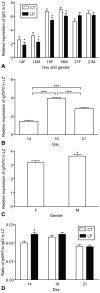
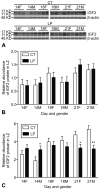

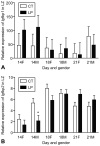
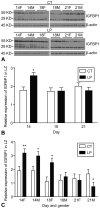
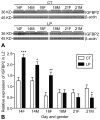
Similar articles
-
Maternal insulin-like growth factor 1 and 2 differentially affect the renin-angiotensin system during pregnancy in the guinea pig.Growth Horm IGF Res. 2015 Jun;25(3):141-7. doi: 10.1016/j.ghir.2015.02.001. Epub 2015 Feb 20. Growth Horm IGF Res. 2015. PMID: 25748140
-
Maternal protein restriction reduces expression of angiotensin I-converting enzyme 2 in rat placental labyrinth zone in late pregnancy.Biol Reprod. 2012 Feb 9;86(2):31. doi: 10.1095/biolreprod.111.094607. Print 2012 Feb. Biol Reprod. 2012. PMID: 22011389 Free PMC article.
-
Maternal exercise in rats upregulates the placental insulin-like growth factor system with diet- and sex-specific responses: minimal effects in mothers born growth restricted.J Physiol. 2018 Dec;596(23):5947-5964. doi: 10.1113/JP275758. Epub 2018 Jul 26. J Physiol. 2018. PMID: 29953638 Free PMC article.
-
Maternal hypothyroidism in rats impairs placental nutrient transporter expression, increases labyrinth zone size, and impairs fetal growth.Placenta. 2023 Aug;139:148-158. doi: 10.1016/j.placenta.2023.06.010. Epub 2023 Jun 22. Placenta. 2023. PMID: 37406552
-
Distinct actions of insulin-like growth factors (IGFs) on placental development and fetal growth: lessons from mice and guinea pigs.Placenta. 2008 Mar;29 Suppl A:S42-7. doi: 10.1016/j.placenta.2007.12.002. Epub 2008 Jan 11. Placenta. 2008. PMID: 18191196 Review.
Cited by
-
Appetite regulation is independent of the changes in ghrelin levels in pregnant rats fed low-protein diet.Physiol Rep. 2015 Apr;3(4):e12368. doi: 10.14814/phy2.12368. Physiol Rep. 2015. PMID: 25907788 Free PMC article.
-
Perinatal Nutrition and Programmed Risk for Neuropsychiatric Disorders: A Focus on Animal Models.Biol Psychiatry. 2019 Jan 15;85(2):122-134. doi: 10.1016/j.biopsych.2018.08.006. Epub 2018 Aug 23. Biol Psychiatry. 2019. PMID: 30293647 Free PMC article. Review.
-
Hydrogen-rich water ameliorates rat placental stress induced by water restriction.Med Gas Res. 2018 Sep 25;8(3):79-84. doi: 10.4103/2045-9912.241064. eCollection 2018 Jul-Sep. Med Gas Res. 2018. PMID: 30319761 Free PMC article.
-
Sex-dependent effects of prenatal food and protein restriction on offspring physiology in rats and mice: systematic review and meta-analyses.Biol Sex Differ. 2021 Feb 9;12(1):21. doi: 10.1186/s13293-021-00365-4. Biol Sex Differ. 2021. PMID: 33563335 Free PMC article.
-
Amino Acids in Reproductive Nutrition and Health.Adv Exp Med Biol. 2020;1265:111-131. doi: 10.1007/978-3-030-45328-2_7. Adv Exp Med Biol. 2020. PMID: 32761573 Free PMC article. Review.
References
-
- Roberts CT, Owens JA, Sferruzzi-Perri AN. Distinct actions of insulin-like growth factors (IGFs) on placental development and fetal growth: lessons from mice and guinea pigs. Placenta. 2008;29(Suppl A):S42–S47. - PubMed
-
- Sferruzzi-Perri AN, Owens JA, Pringle KG, Robinson JS, Roberts CT. Maternal insulin-like growth factors-I and -II act via different pathways to promote fetal growth. Endocrinology. 2006;147:3344–3355. - PubMed
-
- Constancia M, Hemberger M, Hughes J, Dean W, Ferguson-Smith A, Fundele R, Stewart F, Kelsey G, Fowden A, Sibley C, Reik W. Placental-specific IGF-II is a major modulator of placental and fetal growth. Nature. 2002;417:945–948. - PubMed
Publication types
MeSH terms
Substances
Grants and funding
LinkOut - more resources
Full Text Sources
Medical
Miscellaneous

